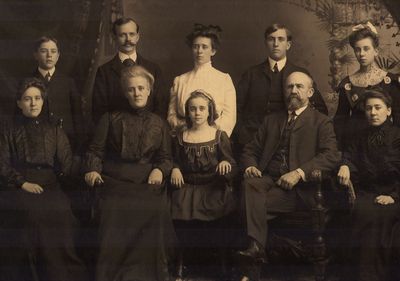Charles Moogk
In 1899 Charles Moogk became the Town of Waterloo’s first full-time
engineer. The “gruff perfectionist” was asked to take the position after
working for twenty-five years as a builder and architect. It was Moogk’s
reputation for hard work and precision that got him the job. In fact, it
is said that Moogk, who left school at 13-years-old, got many of his design ideas from studying architecture books lent to him by a local doctor.
“Although he had never attended a formal school of instruction, Moogk exhibited considerable talent as an architect, having an innate ability to put together plans for all types of construction in the residential, civic and business fields.”
Moogk’s work ethic was legendary. There is a story that he ordered a firewall of one civic building torn down because it looked sloppy – even though the actual wall would never be seen. Moogk also supervised the paving of Erb Street in 1924 from his bed while he lay dying of cancer. Workers brought photographs of the Erb Street project into his home for his approval and Moogk died the day after the paving job was finished.
Moogk was born Carl Moogk in Preston in 1848. When he was just 9-years-old his father, a carpenter, died. After that, the promising young man was helped by his stepfather, George M. Roos and by Otto Klotz, a spokesman for the German-speaking people living in Preston. Klotz gave young Carl an English-language dictionary as a Christmas present in 1857. The ambitious entrepreneur anglicized his first name sometime before the 1870s.
As a young man, Moogk left Preston for Detroit to learn the carpentry trade himself. He came back to the area, working on some construction projects, but soon left for the United States again where he met and married Josephine Lockard in 1873.
The young couple came back to Canada, this time to Waterloo after Moogk heard of a job building the new Waterloo Village Hall at Erb and Albert Streets. This municipal project would be the first of many for Moogk. While Moogk’s career as a builder blossomed along with the growing Town of Waterloo, his wife was busy raising their twelve children. Moogk was remembered as a stern father; however, his eldest daughter Salome said that in the last few months of his life, Moogk told her he regretted not being able to show affection to his children.
Moogk built the family home himself in 1878 on the corner of Cedar and Queen (Regina) Streets. He also built many other houses including one for Herbert Snyder of Snyder Furniture which was bought by Edward Seagram in 1928. He had his hand in the building of many civic buildings including the old fire hall, the Carnegie Library, and the market building, all on Albert Street. He was involved in the building of St. John’s Lutheran Church, St. Louis Roman Catholic Church and the Erb Street Mennonite Church.
Charles Moogk was employed by the Village at a time when many services were expanding including gas, electricity, water, and sewage systems. Moogk was also given the job of developing a comprehensive street numbering system in the early 1900s.
His obituary read: “He had a wonderful memory and it was rarely necessary for him to consult his maps when the location of streets, buildings, sewers, storm drains, water and gas mains was questioned.”
Photo courtesy of the Waterloo Public Library
Charles Moogk (Waterloo 150 Profile)
Description
- Creator
- Gallagher, Beth, Author
- Media Type
- Text
- Image
- Description
- To celebrate Waterloo's 150th anniversary, the Waterloo Public Library published a book called "Profiles from the Past, Faces of the Future." This book featured 150 profiles of people who helped make Waterloo what it is today. This is the digitized profile for Charles Moogk.
- Notes
- Please visit the Waterloo Public Library to enquire about physical copies of "Profiles from the Past, Faces of the Future."
The Waterloo 150 project was funded by a grant from the Waterloo Regional Heritage Foundation. Beth Gallagher wrote the profiles with the assistance of many research volunteers. Information for the profiles was gathered from a variety of sources from the community and the Ellis Little Local History Room. Notable sources include the Ellis Little Papers, newspaper clippings, local magazines and books.
- Place of Publication
- Waterloo, Ontario
- Date of Publication
- 2007
- Subject(s)
- Personal Name(s)
- Moogk, Charles ; Roos, George ; Klotz, Otto ; Moogk, Carl ; Lockard, Josephine ; Moogk, Salome
- Language of Item
- English
- Geographic Coverage
-
-
Ontario, Canada
Latitude: 43.4668 Longitude: -80.51639
-
- Copyright Statement
- Uses other than research or private study require the permission of the rightsholder(s). Responsibility for obtaining permissions and for any use rests exclusively with the user.
- Contact
- Waterloo Public LibraryEmail:askus@wpl.ca
Website:
Agency street/mail address:35 Albert Street, Waterloo, Ontario, Canada, N2L 5E2
- Full Text




